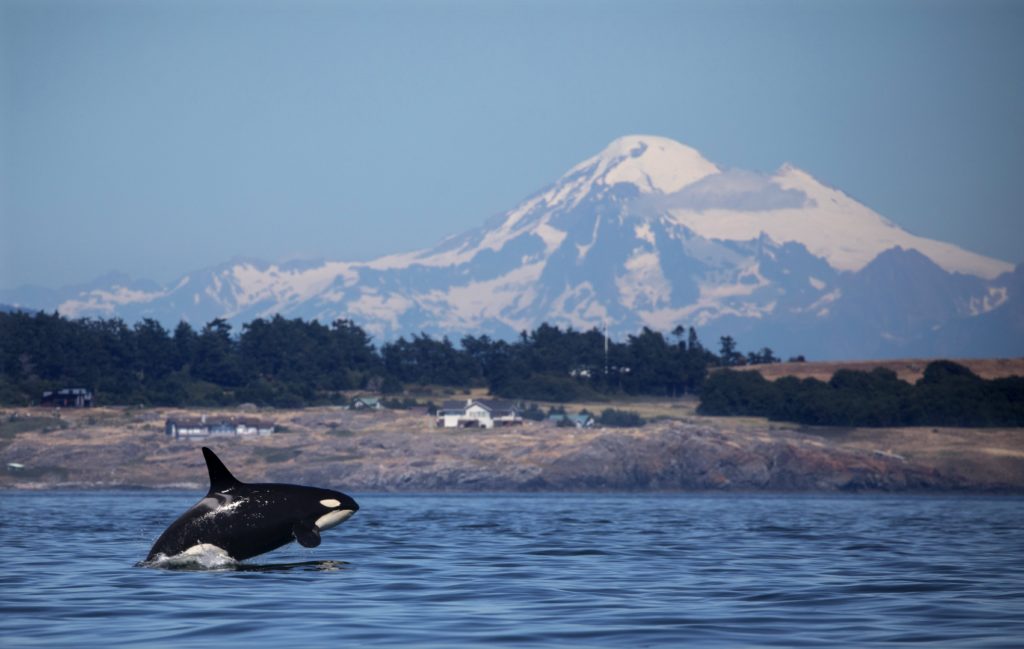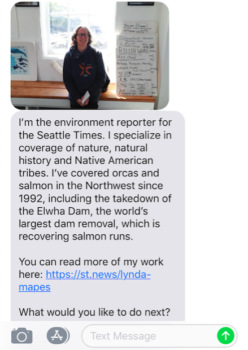How the Seattle Times used a breaking news approach on enterprise reporting
Ben Woodard, Lynda Mapes and Danny Gawlowski, The Seattle Times,This is a series on Better News to a) showcase innovative/experimental ideas that emerge from the Knight-Lenfest Newsroom Initiative and b) to share replicable tactics that benefit the news industry as a whole. This “win” comes from Assistant Metro Editor Ben Woodard, Environment Reporter Lynda Mapes and Assistant Managing Editor Danny Gawlowski of the Seattle Times.
Question: What problem were you trying to solve, and why was solving the problem strategically important for your organization?
Answer: In early 2018, Lynda Mapes pitched a bold project to track the health of Puget Sound’s critically endangered orcas. The orca inhabits the waters near Seattle and is a signature animal of our region. Our plan started to take form in a traditional Seattle Times way: We were looking at publishing a series of articles that would each tell a part of the story and be published over several days in early 2019.
But breaking news interrupted this plan, forcing us to move faster. One of our local southern resident orcas gave birth to a calf that lived for just one half-hour. Mother orca Tahlequah had carried the calf for more than 1,000 miles and 17 days, capturing worldwide attention. The interest in the story was so intense we decided to change our plan and publish our series as soon as each piece was ready. We also wanted to weave in breaking news as it happened. The shift in strategy worked, drawing more than 6 million page views and hundreds of subscriptions through 2018.

Mount Baker provides a spectacular backdrop for K20, a female born in 1986. Orcas can swim 75 miles a day and more, with bursts of speed up to 30 mph, and are capable of diving deeper than 3,000 feet. (Steve Ringman/The Seattle Times)
Q: How is this approach related to Table Stakes (e.g. one of the 7 Table Stakes and/or an outgrowth of the Knight-Lenfest initiative, etc.)?
A: This approach is directly related to Tables Stake No. 3: Produce and publish continuously to meet audience needs. We needed to adopt our traditional publishing plan that was built around a print-centric approach to publish in a way that better served our audiences.
Q: How did you go about solving the problem?
A: We were really fortunate to have assigned Ben Woodard, assistant metro editor, to this project. Ben is a digital-native editor who started his Seattle Times career as a homepage producer and has spent a few years working on the breaking news beat. His approach has been refined on coverage of news events, such as Seattle’s May Day protests. In coverage of events like this, he helped formalize a strategy of continuously publishing a live blog of quick updates throughout the day, followed by a comprehensive analysis at the end of the day.

Pictured here is a screenshot from one of the text messages that followers of the orca stories received from the reporter.
Ben scaled this basic approach and applied it to our orca coverage. Instead of waiting for a comprehensive project to be completed, Lynda shifted to writing daily stories on the plight of the orca mother. Her research and knowledge led to incredibly informative breaking news coverage. At the same time, she continued working on her enterprise stories, and we published those as they became ready.
Meanwhile, Ben and Sean Quinton, who was Metro section producer at the time, managed most of our social media coverage. We mentioned these stories in our daily newsletters, in breaking news email alerts and in breaking news push notifications. We also experimented with using GroundSource, a text-message tool we used to send messages to more than 1,500 people who signed up for updates. Those readers also sent us questions that Lynda directly answered, and the tool allowed us to alert people when new stories were published.
Instead of publishing four or five long reads, Lynda ended up writing several dozen stories, a mix of short updates, answers to reader questions and longer enterprise reporting. She also participated in a Facebook Live session, in which the audience could ask questions while Lynda discussed the issues surrounding orcas with prominent Washington state figures.
Q: What worked?
A: The approach truly engaged our audiences. During one week, Lynda’s orca reporting accounted for nearly 20 percent of all of our site’s page views. The coverage led to hundreds of new digital subscriptions, which is a major focus of our business strategy.
In addition, the reporting has helped shape state policy. Washington state created a task force to look into the issues and the governor has proposed $1.1 billion in funding to make changes to help orca and salmon.
Q: What didn’t work?
A: We should have taken this approach sooner. It was driven primarily by us reacting to the breaking news developments. But, had we started this sooner, we could have helped explain some of these issues beforehand.
Q: What happened that you didn’t expect?
A: We knew that people who live in this region deeply care about the orcas that share our home. However, we did not anticipate the strong appetite for and response to this coverage. It was beyond our expectations. It continues to be.
Q: What would you do differently now? What did you learn?
A: We need to apply this approach to all of our major enterprise reporting. We should not have to wait for situations of major breaking news to take this approach. We believe that this approach of providing a mix of shorter updates, in-depth analysis and interactive elements (like the Facebook Live interview and reader Q&A) can benefit other stories as well. We need to think of our projects more like reporting beats rather than single stories.
Q: What advice would you give to others who try to do this?
A: Listen to your audience and find the stories that will lend themselves to this approach. At the very least, follow up your major enterprise reporting with shorter posts that invite (and respond to) readers’ questions and comments.
Q: Anything else you want to share about this initiative?
A: The Seattle Times is known for our rich, multimedia reporting and this project was no exception. The success of this project was greatly enhanced by the richness of the visual reporting by photographer Steve Ringman, video editor Lauren Frohne, video editor Ramon Dompor, graphic artist Emily Eng, assistant managing editor Frank Mina and many others.
Here’s a sample of our best coverage:
- Hostile waters: Orcas in peril
- Why are Puget Sound’s orcas dying?
- The orca and the orca catcher
- Hunger: The decline of salmon adds to the struggle of Puget Sound’s orcas